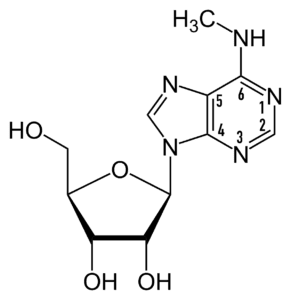

The illustration shows a methyl (CH3-) group added to the nitrogen that is attached to the #6 carbon of the purine base adenine. The entire molecule, with the ribose, is called N6-methyladenosine (m6A). Methylation of adenosine is carried out by enzymes that bind the RNA in the cell cytoplasm.
The m6A modification is found in multiple RNAs of most eukaryotes. It has also been found in the genome of RNA animal viruses. The modification is added to RNAs by a multi-protein enzyme complex, and is removed by demethylases. Silencing of the methylases decreases HIV-1 replication, while depletion of demethylases has the opposite effect. The replication of other viruses, including hepatitis C virus and Zika virus, is also regulated by m6A modification, but the details differ. For example, m6A negatively affects the replication of the flaviviruses hepatitis C virus and Zika virus.
Methylation of adenosine has been recently shown to modulate the replication of plant viruses. The RNA genomes of alfalfa mosaic virus (AMV) and cucumber mosaic virus (CMV) were found to contain m6A. An m6A demethylase was identified in Arabidopsis thaliana, a small flowering plant commonly used in research. This demethylase protein bound the capsid protein of AMV but not of CMV. Elimination of the demethylase from Arabidopsis reduced the replication of AMV but not CMV. These results show that m6A methylation negatively regulates the replication of AMV. Binding of the AMV capsid protein to the m6A demethylase might be a mechanism for ensuring that the enzyme demethylates viral RNA, allowing for efficient viral replication.
While it is clear that m6A regulates the replication of RNA viruses, the mechanisms involved are not well understood. Methylation of adenosine is likely to affect multiple functions, including the structure, celllular localization, splicing, stability, and translation of viral RNA (link to review). As m6A is also found in cellular RNAs, studies of its effect on viral processes is likely to provide insight into its role in cellular biology.

Pingback: Have a methyl with your viral RNA - VETMEDICS